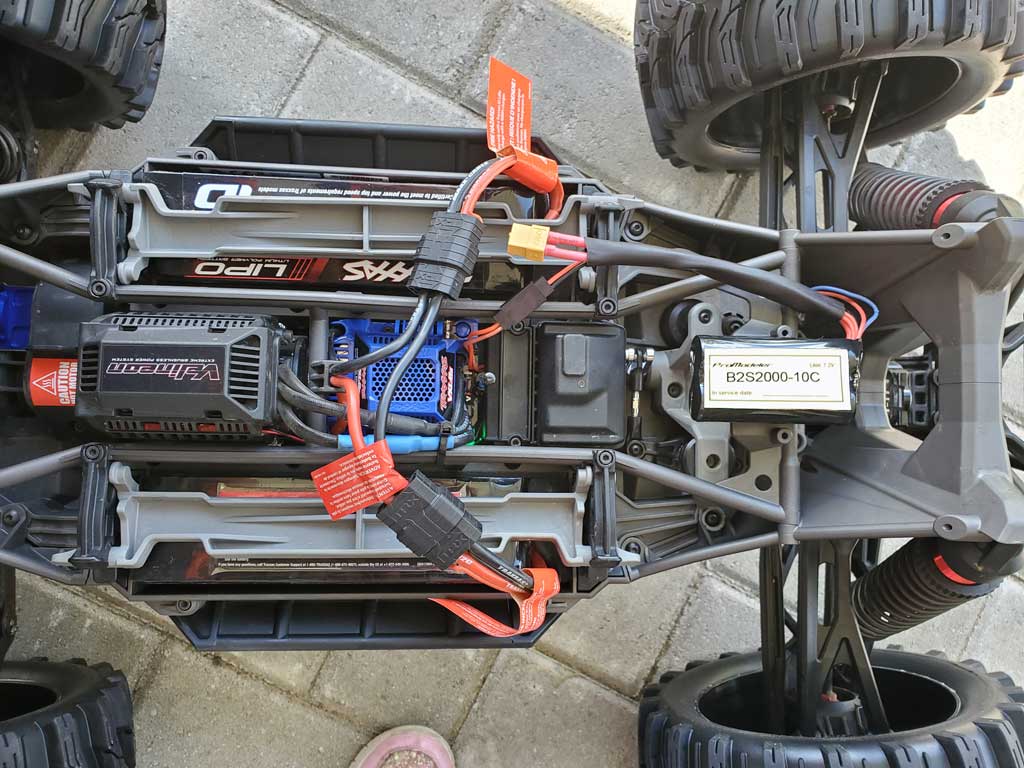This power adapter is what you need to power a HV steering servo separately from the 6V radio system without burning up the receiver/ESC.

- This adapter gives the servo 10A of HV while the receiver runs on a BEC
Background:
The stock TRAXXAS radio system operates on 6V. The 6V-receiver is backfed through the throttle lead coming from the ESC (through what's called a BEC-circuit). BEC stands for battery eliminator circuit and ESC means electronic speed control, or throttle (for the propulsion motor).
Basically, a BEC is like a parasite because it steals juice from the propulsion batteries (the ones that power the rig's drive wheels) to supply control-power for the radio, or control-system (this also costs you some running time, of course). Thus, it's through a BEC that low-end radio systems (and the steering servo) are powered.
While this is fine for toys because it's a cheap solution (remember, the whole package price is what they're concerned with), once you want to install a high performance steering-servo, the whole house of cards falls down because SV-systems (standard-voltage, or 6V) as produced by a cheapo BEC is simply not powerful enough (it also doesn't have the balls to power a real servo even at 6V because it doesn't produce enough current).
Recap:
So the problem is, when it's time to upgrade the steering servo, because the best servos are optimized for 8.4V (what's called HV for high voltage), then the dealer chuckles and reaches under the counter to pull out a new HV radio system for another few hundred bucks. This is how the game is played, e.g. lure you in with something that's great fun and once you discover the limits, sell you upgrades so you can really enjoy it.
Solution:
Thing is, you don't have to do that because there's another way. Best part is, it doesn't have to cost much! This little adapter divorces the control power (for just the steering servo) from the receiver. Now you can connect an 8.4V source without frying the 6.0V receiver! And note, unlike cheapo imports, this one's made with 20AWG vs. thinner 22AWG leads for higher current handling capability - details matter, right?

- Using a 10A HV2SV power adapter is slick solution that saves money!
ProTip; the high voltage source can either be a reliable 2S2000 battery pack, suitable for 6-8 runs between charges - or - an aftermarket BEC. Servos don't really care, and both of these links will open a separate tab in your browser . . . but sensitive electronics do better with clean battery power. Fact. Anyway, we offer you both (BEC and batteries) so we don't really care which you get, but we recommend the battery.
Yes, this means powering your radio system just like the gas-powered trucks but because batteries are a significantly less noisy power source than anything synthetically derived from the propulsion battery, the system isn't stressed as much. Basically, a BEC (and we mean any BEC regardless of how expensive) when compared to a battery (even the cheapest) outputs junk, e.g. very dirty/noisy electricity (click the link to learn more). Why? Physics.

- 2S2000 LiIon cells (durable steel shells) secured with heavy duty Velcro
Bottom line? Your money, do whatever you want but we don't ever recommend anything but a battery to those who want the best source of electric current possible. Anyway, with this adapter, your poor receiver won't go poof as it suddenly releases the magic smoke from inside, which keeps it working (just kidding of course, the 'poof' is the 6V receiver frying from over-voltage, e.g. burning up, if you were to try using 8.4V).

- Doesn't look like much but it works and saves from buying a pricey radio!